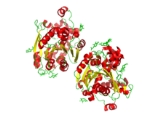
Gastric lipase
Encyclopedia
Gastric lipase, also known as LIPF, is an enzymatic
protein
that, in humans, is encoded by the LIPF gene.
secreted by the gastric chief cell
s in the fundic
mucosa in the stomach
. It has a pH optimum of 3-6. Gastric lipase, together with lingual lipase
, comprise the two acidic lipases. These lipases, unlike alkaline lipases (such as pancreatic lipase
), do not require bile acid
or colipase
for optimal enzymatic activity. Acidic lipases make up 30% of lipid hydrolysis
occurring during digestion in the human adult, with gastric lipase contributing the most of the two acidic lipases. In neonates, acidic lipases are much more important, providing up to 50% of total lipolytic activity.
, but the diacylglycerol cannot be transported across. This leaves the acidic lipases less efficient than alkaline lipases.
(Ser-153, His-353, Asp-324) and an oxyanion hole (backbone NH groups of Gln-154 and Leu-67) analogous to serine protease
s.
Enzyme
Enzymes are proteins that catalyze chemical reactions. In enzymatic reactions, the molecules at the beginning of the process, called substrates, are converted into different molecules, called products. Almost all chemical reactions in a biological cell need enzymes in order to occur at rates...
protein
Protein
Proteins are biochemical compounds consisting of one or more polypeptides typically folded into a globular or fibrous form, facilitating a biological function. A polypeptide is a single linear polymer chain of amino acids bonded together by peptide bonds between the carboxyl and amino groups of...
that, in humans, is encoded by the LIPF gene.
Function
Gastric lipase is an acidic lipaseLipase
A lipase is an enzyme that catalyzes the formation or cleavage of fats . Lipases are a subclass of the esterases.Lipases perform essential roles in the digestion, transport and processing of dietary lipids in most, if not all, living organisms...
secreted by the gastric chief cell
Gastric chief cell
A gastric chief cell is a cell in the stomach that releases pepsinogen, gastric lipase and Chymosin...
s in the fundic
Fundic glands
The fundus glands are found in the body and fundus of the stomach.They are simple tubes, two or more of which open into a single duct.-Pathology:...
mucosa in the stomach
Stomach
The stomach is a muscular, hollow, dilated part of the alimentary canal which functions as an important organ of the digestive tract in some animals, including vertebrates, echinoderms, insects , and molluscs. It is involved in the second phase of digestion, following mastication .The stomach is...
. It has a pH optimum of 3-6. Gastric lipase, together with lingual lipase
Lingual lipase
Lingual lipase is a member of a family of digestive enzymes called lipases, EC 3.1.1.3, that use the catalytic triad of Aspartate , Histidine , and Serine to hydrolyze long-chain triglycerides into partial glycerides and free fatty acids. The enzyme catalyzes the first reaction in the digestion of...
, comprise the two acidic lipases. These lipases, unlike alkaline lipases (such as pancreatic lipase
Pancreatic lipase
Pancreatic lipase, also known as pancreatic triacylglycerol lipase, is secreted from the pancreas, and is the primary lipase that hydrolyzes dietary fat molecules in the human digestive system, converting triglyceride substrates found in ingested oils to monoglycerides and free fatty acids.Bile...
), do not require bile acid
Bile acid
Bile acids are steroid acids found predominantly in the bile of mammals. Bile salts are bile acids compounded with a cation, usually sodium. In humans, the salts of taurocholic acid and glycocholic acid represent approximately eighty percent of all bile salts. The two major bile acids are cholic...
or colipase
Colipase
Colipase is a protein co-enzyme required for optimal enzyme activity of pancreatic lipase. It is secreted by the pancreas in an inactive form, procolipase, which is activated in the intestinal lumen by trypsin...
for optimal enzymatic activity. Acidic lipases make up 30% of lipid hydrolysis
Hydrolysis
Hydrolysis is a chemical reaction during which molecules of water are split into hydrogen cations and hydroxide anions in the process of a chemical mechanism. It is the type of reaction that is used to break down certain polymers, especially those made by condensation polymerization...
occurring during digestion in the human adult, with gastric lipase contributing the most of the two acidic lipases. In neonates, acidic lipases are much more important, providing up to 50% of total lipolytic activity.
Clinical significance
Gastric lipase can partially compensate for the decrease in production of pancreatic lipase associated with pancreatic dysfunction, giving some means for the body to digest lipids. A limitation of acidic lipases is that they remove only one fatty acid from each triacylglycerol. The free fatty acid can readily cross the epithelial membrane lining the gastrointestinal tractGastrointestinal tract
The human gastrointestinal tract refers to the stomach and intestine, and sometimes to all the structures from the mouth to the anus. ....
, but the diacylglycerol cannot be transported across. This leaves the acidic lipases less efficient than alkaline lipases.
Structure
Gastric lipase is a polypeptide of 371 residues in length. The structure of gastric lipase was determined using X-ray diffraction with a resolution of 3.00 Å, and is composed of 41% helices and 14% beta sheets. Gastric lipase belongs to the α/β-hydrolase-fold family. It possesses a classical catalytic triadCatalytic triad
A catalytic triad refers to the three amino acid residues found inside the active site of certain protease enzymes: serine , aspartate , and histidine . They work together to break peptide bonds on polypeptides. In general terms, catalytic triad can refer to any set of three residues that function...
(Ser-153, His-353, Asp-324) and an oxyanion hole (backbone NH groups of Gln-154 and Leu-67) analogous to serine protease
Serine protease
Serine proteases are enzymes that cleave peptide bonds in proteins, in which serine serves as the nucleophilic amino acid at the active site.They are found ubiquitously in both eukaryotes and prokaryotes...
s.

